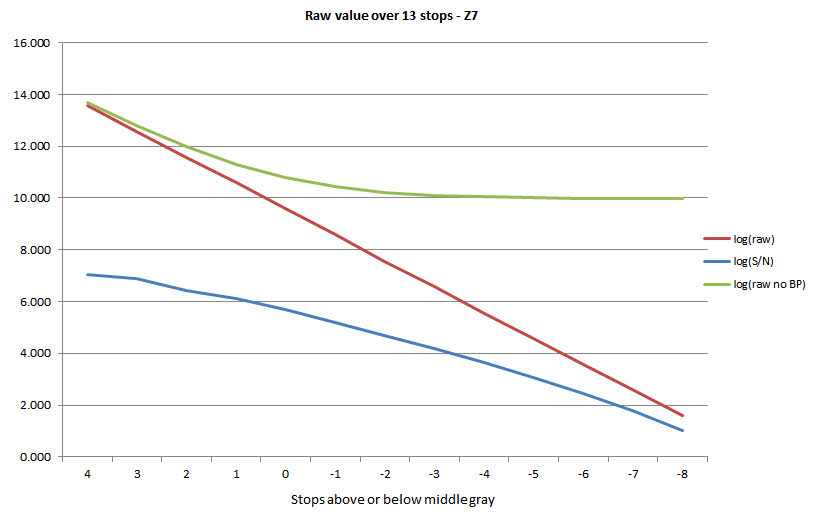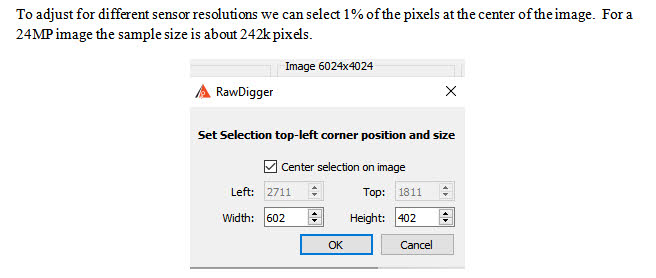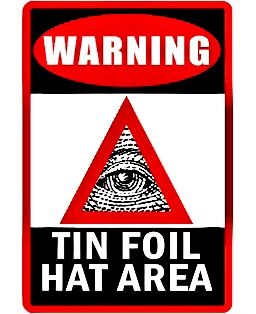Update to Blinkes/Zebra warnings
Jan 12, 2023 10:59:49 #
After a recent conversation with Bill Claff I revisited this subject. It turns out that what is recorded in the raw file has an interesting behavior that is seldom discussed.
The first two cameras I tested were the Nikon D610 and Df. Both of them record the raw values directly with no adjustment for black levels. Both of them produce a linear response.
But the Sony A7 II, Fuji X100T and Z7 record the raw values differently and then apply a black level adjustment by subtracting a constant from the raw values to achieve the linear response. Before subtracting that constant the recorded raw values are progressively higher than the final linear results reported by RawDigger as the exposure drops from maximum white down to very dark.
If you look at this in RawDigger the Black Level default is set to Auto. The Subtract Black checkbox is selected on the screen under that button.
The research I did over the past week supports my earlier findings but it is more specific. The bottom line is that, if you know when the highlight warnings start, you can get as close as you can get to ETTR as possible. The exception is the A7 II where the blinkies and Zebra warnings start over a full stop before reaching the limit.
Nevertheless, if the blinkies are showing over a portion of the image where the highlights are not important, there is no harm in going a little higher.
To keep this thread from getting moved out of the Main Photography Discussion I will provide an example from the Z7 and a document that describes all of this in more detail.
The first two cameras I tested were the Nikon D610 and Df. Both of them record the raw values directly with no adjustment for black levels. Both of them produce a linear response.
But the Sony A7 II, Fuji X100T and Z7 record the raw values differently and then apply a black level adjustment by subtracting a constant from the raw values to achieve the linear response. Before subtracting that constant the recorded raw values are progressively higher than the final linear results reported by RawDigger as the exposure drops from maximum white down to very dark.
If you look at this in RawDigger the Black Level default is set to Auto. The Subtract Black checkbox is selected on the screen under that button.
The research I did over the past week supports my earlier findings but it is more specific. The bottom line is that, if you know when the highlight warnings start, you can get as close as you can get to ETTR as possible. The exception is the A7 II where the blinkies and Zebra warnings start over a full stop before reaching the limit.
Nevertheless, if the blinkies are showing over a portion of the image where the highlights are not important, there is no harm in going a little higher.
To keep this thread from getting moved out of the Main Photography Discussion I will provide an example from the Z7 and a document that describes all of this in more detail.
Jan 12, 2023 11:03:09 #
Here is a sample plot of the raw values for the Z7 along with a PDF you can download.
Jan 13, 2023 07:42:16 #
Jan 13, 2023 08:23:42 #
selmslie wrote:
After a recent conversation with Bill Claff I revi... (show quote)
Perhaps theres a reason that this is "seldom discussed".
Jan 13, 2023 09:07:55 #
User ID wrote:
Perhaps theres a reason that this is "seldom discussed".
There have been 30 threads on the subject of ETTR since 2014. Many of them have been misleading and based on a lack of understanding.
There have also been 19 threads on the subject of blinkies since 2012.
ETTR is all about the maximizing exposure without blowing the raw highlights.
Learning about how the blinkies work in relation to the raw limit on your own cameras is the ultimate answer.
Jan 13, 2023 10:41:50 #
selmslie wrote:
There have also been 19 threads on the subject of blinkies since 2012.
And another 4 threads on highlight warnings.
Jan 13, 2023 12:00:27 #
selmslie wrote:
And another 4 threads on highlight warnings.
Just 53 threads total ? And half of them authored by you ? Compare that to the 984 threads about what lenses to bring on a cruise !
Jan 13, 2023 12:11:59 #
selmslie wrote:
.....if you know when the highlight warnings start, you can get as close as you can get to ETTR as possible.....
You seem to be saying that this is the most consistent way of getting close to saturation. Do all cameras have to be assessed individually or can you say that all model X cameras have Y amount of headroom above the onset of the blinkies?
Jan 13, 2023 13:22:20 #
R.G. wrote:
You seem to be saying that this is the most consistent way of getting close to saturation. Do all cameras have to be assessed individually or can you say that all model X cameras have Y amount of headroom above the onset of the blinkies?
Three of the bodies I have tested - D610 (2013), Df (2013) and Z7 (2020) - are very consistent so I would guess that they are following an established Nikon standard.
I can't say that the Sony A7 II and Fuji X100T (both 2014) are typical of their brands or that other companies are as consistent in their standards.
But the test as I described in the PDF it is relatively simple. All anyone needs is a copy of RawDigger.
You don't even need a calibrated screen since you only need to look at a single image, the one where the blinkies just start.
Jan 13, 2023 13:26:56 #
User ID wrote:
Just 53 threads total ? And half of them authored by you ? Compare that to the 984 threads about what lenses to bring on a cruise !
Considering the nature of cruising and the restrictions of on-shore tours, all you really need is a smart phone. That goes for bus tours too.
It's when you rent a car and have full control of your itinerary that you can take advantage of more sophisticated equipment.
Jan 13, 2023 19:10:09 #
a6k
Loc: Detroit & Sanibel
selmslie wrote:
...snip..
But the test as I described in the PDF it is relatively simple. All anyone needs is a copy of RawDigger.
..snip...
But the test as I described in the PDF it is relatively simple. All anyone needs is a copy of RawDigger.
..snip...
I have no problem with RawDigger but FWIW, FastRawViewer (FRV) (same origins?) allows one to increment the way an exposure looks until the OE indicator begins to show. I have compared the results between the two products and I find little or no difference in the result. The advantages, then, are:
1. FRV is an excellent application for everyday purposes in reviewing the results of sessions, culling, etc.
2. FRV, given an exposure anywhere near that which produces maximum values, can quickly be incremented with keystrokes and thus save the user the work or time in taking a series of exposures to get the answer to the "how much is too much" question.
3. Because FRV can be used on exposures that were not necessarily taken only for test purposes, it can help make practical sense of the "how to use this information" challenge.
4. I don't recall exactly how to use RD for this kind of testing but FRV can be set to increment in 1/6 stop levels. This allows a lot of precision if you want it. Most cameras in my experience only increment in 1/3 stops. My Sony's can be adjusted in the menu options in 1/6 stops (IIRC) so that the additional precision can be made use of: half of the answer is in the meter adjustment and the other half is in the answer to the zebra or blinkies issue. I can only guess if the meters can be adjusted like that on other brands.
Thanks for this thread.
Jan 14, 2023 05:04:54 #
a6k wrote:
I have no problem with RawDigger but FWIW, FastRawViewer (FRV) (same origins?) allows one to increment the way an exposure looks until the OE indicator begins to show. I have compared the results between the two products and I find little or no difference in the result. The advantages, then, are:
1. FRV is an excellent application for everyday purposes in reviewing the results of sessions, culling, etc. ...
1. FRV is an excellent application for everyday purposes in reviewing the results of sessions, culling, etc. ...
RawDigger and FRV both come from the same source, LibRaw LLC.
I use RawDigger mainly for researching the behavior of camera sensors, seldom for culling and only because I didn't keep FRV installed.
I usually cull in the camera based on highlight warnings and that leaves me with only the images that I can process easily in Capture One.
Another of their products that is designed for users who have had their color filter arrays removed is Monochrome2DNG that I use with the A7 II monochrome. It's found through the FRV website.
If you want to reply, then register here. Registration is free and your account is created instantly, so you can post right away.




